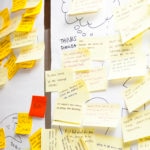Design Thinking, the human approach to business
The method aims to deal with the challenges of managing a company in the same way that designers tackle design problems.

“Some years ago, when the Swiss company Zyliss tasked IDEO with creating a new line of kitchen utensils, the first thing we did was to study children and professional cooks, even though none of them had nothing directly to do with the product. But that was precisely the reason the two groups provided such valuable information. A seven-year-old girl who struggled with a can-opener made us think of all the physical difficulties that adults have learned to conceal. The “short-cuts” and tricks of a restaurant chef revealed interesting aspects of equipment maintenance, due to the exceptional cleaning and hygiene demands”.
This is one of the examples to be found in the book entitled Change by Design by Tim Brown, the father of Design Thinking and CEO and chairman of IDEO. The method uses a holistic philosophy to deal with the challenges of managing a company in the same way designers tackle design problems.
And how do the designers do it? At the outset, the first phase involves defining the needs of the through observation and immersion. The second phase is brainstorming and experimentation to come up with all possible ideas before making the final prototype. The third stage is running a number of tests to improve the outcome before implementing the final prototype.
All this in an atmosphere that has to nourish the workers' most creative side. As Brown says: “Creative teams must be given the chance to share ideas not only through words, but also visually and physically. Personally I don't handle reports very well, I feel more comfortable in a room with a group where someone shows a chart, someone else takes notes on a post-it or uploads photos to the wall, and yet another person sitting on the floor tries to make a quick prototype (...) IDEO, for example, assigns "project rooms" for its teams during the time their mission lasts (...).
Brown adds that "The project spaces are large enough that the accumulated research materials, photos, storyboards, concepts, and prototypes can be out and available all of the time. The simultaneous visibility of these project materials help us identify patterns and encourages creative synthesis to occur much more readily than when these resources are hidden away in file folders, notebooks, or PowerPoint decks (...) If you take a look at a project room you'll see prototypes all over the floor (...) You'll see utensils ranging from knives to box-cutters and including Scotch tape”.
The Design Thinking model has five clearly defined steps:
- Empathy: Empathy: You have to know the people and the users. Putting yourself in the end user's shoes observing in an empathetic way. Understanding the customer not as a customer, but as a human being, as a person who has needs, who moves and lives in a context, and has a series of needs that can be satisfied.
- Definition: Definition: The problem needs to be clearly defined in order to satisfy a need, through creativity. the solution so you can reach it.
- Ideas: Ideas: All ideas are valid. The basis of creativity is imagination. Design Thinking is not only launching new products or services, but to ensure that none of the areas in the company becomes obsolete.
- Prototypes: Prototypes: Use vision. Seeing and feeling a prototype is worth more than a printed image on.
- Evaluation: Evaluation: Evaluating is measuring. Feedback. Give users the prototype without any them have the experience of holding it and being able to compare it with another similar product. You need to understand their environment and their motivations, and to consider to what extent a proposed solution has ramifications that go beyond simply using or consuming that product, but may also sometimes even have social implications.
For Tom Kelley, a partner in IDEO, the model is “a mixture of humanity and technology”. As he says in this interview with El Mundo: “When you bring people together from different parts of the economy or public life, the one thing they have in common is that they are human. If you apply a human-centered approach to business, politics, art, everyone will support that point of view or philosophy. It is this common ground that we nurture". Kelley also notes: "Long-term innovation is not expensive, what's expensive is being mediocre". And he points out that his model “is for optimists”.